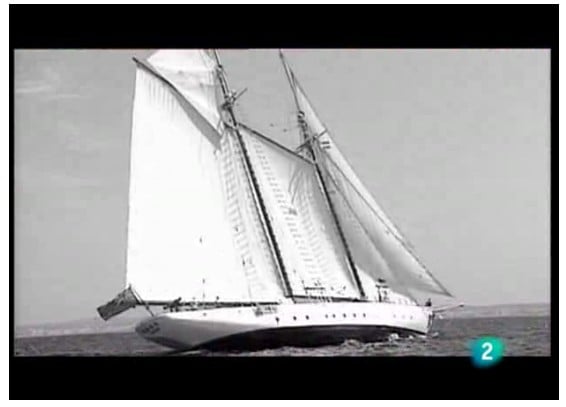

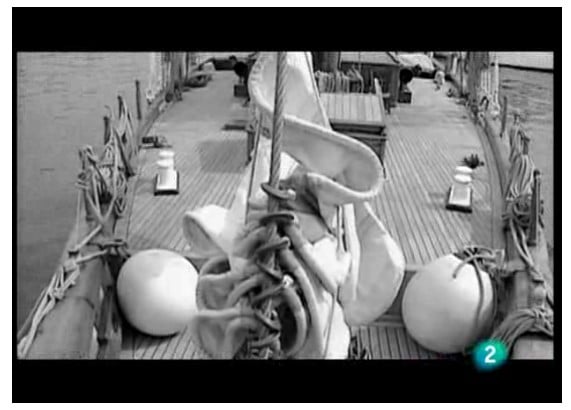
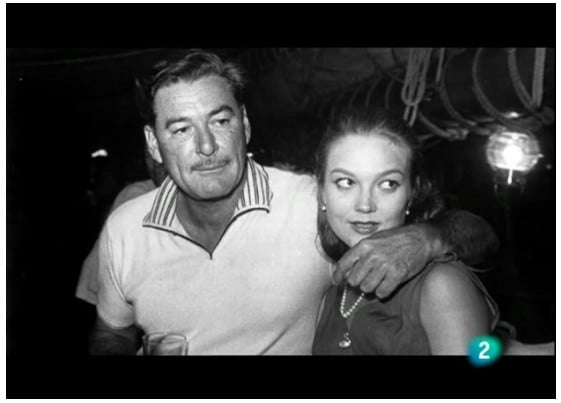
— David DeWitt
Dine In Like Flynn. In The Zaca, In Captain Errol’s Cabin.
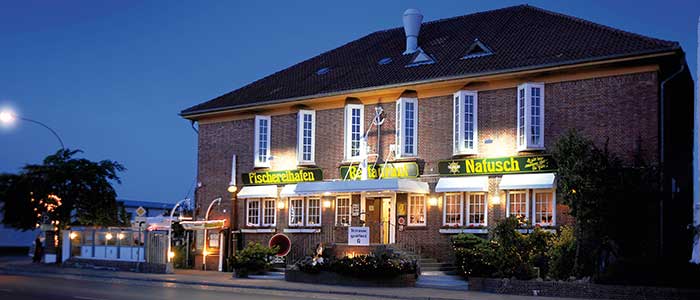
nord24.de/bremerhaven/auf-einen-drink-in-der-kajuete-von-errol-flynn…
[You can click at article’s bottom for English.]
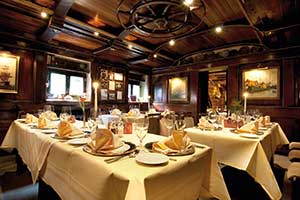
— Tim
“The Biggest Tiki Party on the Planet”
With a discussion of In the Wake of the Bounty, and other Bounty films, et al.
Beginning today in San Diego
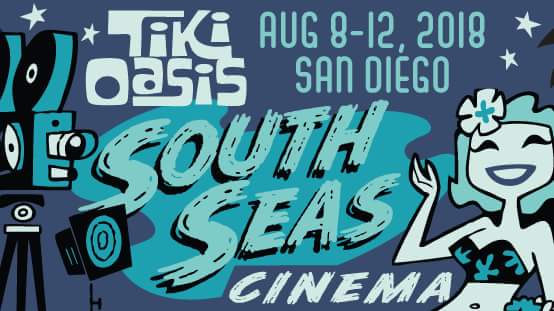
Friday 11:30am-12:30: Sex in South Seas Cinema
Ed Rampell is an L.A.-based full-time freelance writer and author. In this titillating symposium, Rampell will expose everything you ever wanted to know about Sex in South Seas Cinema. The film genre that offers the allure of South Seas sirens, naked nymphs, bronzed gods and goddesses, sensual dance and the first Western-style kiss on the lips.
Definition of the South Seas Cinema Genre:
[T]he element that distinguishes South Seas Cinema is its depiction of paradise on earth.
[T]he silent films “Tabu” and “Moana of the South Seas” as early examples of the genre. He will be discussing all four of the “Mutiny on the Bounty” films in his Friday Tiki Oasis Symposium: the Clark Gable 1935 film, Marlon Brando’s 1962 one, the more recent Mel Gibson 1984 adaptation as well as the lesser known Errol Flynn film “In the Wake of the Bounty.”
No question why Errol’s film qualified for the festival, just look at the “Otahiti” scenes from about 10:45 to 20:15!
South Seas Cinema Lobby Cards:
——-
Functions at the Bali Hai in San Diego:
www-kpbs-org.cdn.ampproject.org…
Though unmentioned on the event site, Bali Hai is direct descendent of what was once Christian’s Hut in Newport Beach, one of Errol’s old haunts. Here he is there, with Lili, and a mystery woman:
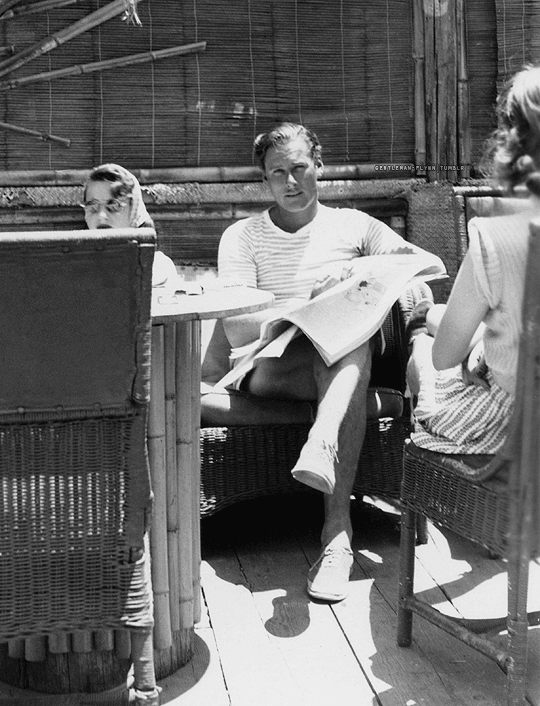
— Tim
To all Flynn aficionados out there, I’m looking for the name of this ship, that was in Errol’s den. I think it was a Dutch man of war, but I don’t know. I have seen many ships on the internet and on many ship model makers that are very similar but it isn’t this exact ship.
I also think that this ship model could be one of the smaller models used in Captain Blood and the model dept at Warners could have given this to Flynn as a gift. They must have copied it from photos of a real ship that had a name to it.
I have a close-up view of this ship but for some reason, I can’t post it in my post here. I’m looking to have a replica made of this ship for my home office. Any help in finding this ship or the name would be an awesome help to me. I’m calling on Gentleman Tim who can find just about anything on Flynn…
Best wishes to you all
Jack Marino
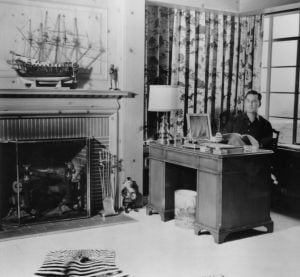
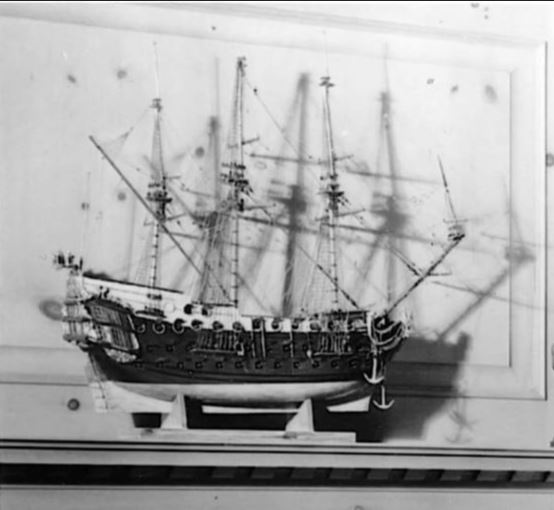
— Jack Marino
In Southern California from Northern Ireland, sailing on the Sirocco, 79 years ago, ~ July 20, 1939.
Rosemary, Errol, Lili, Professor Flynn, and Marelle. The Professor was on summer break as Dean of Sciences Faculty at Queens University in Belfast.
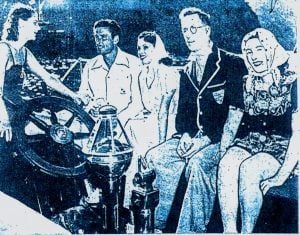
— Tim
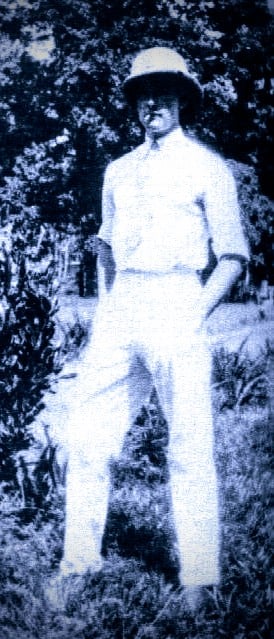
A primer on Flynn’s time and adventures in Papua New Guinea, quoting “Malum Nalu”.
Photo of girl believed to be Tuperselai provided by EFB Author, Tina. Thank you, Tina.
…….
Papua New Guinea’s rich and colorful history is littered with the names of likewise gaudy characters that have carved a niche for themselves.
Few, however, have made more of an impact than the flamboyant and swashbuckling Errol Flynn.
With the discovery of very good paying gold in 1926 at Edie Creek above Wau – six days walk from Salamaua – a gold rush of massive proportions started, not only from Australia but from beyond.
With the major discovery of gold came the last two categories of what the White population of New Guinea was divided into: Missionaries, Moneymakers, and Misfits or Fools, Freaks, and Failures.
Not least among the Misfits was the one who became a Hollywood star – Errol Flynn. And none, probably, has done more to promote PNG than this lovable rogue who went on to become the world’s top sex symbol.
The superb scenery, glorious hills and harbours, white beaches, and shady copra plantations are still today as Flynn describes them in his famous autobiography, My Wicked, Wicked Ways.
Places like Salamaua, Wau, Bulolo, Lae, Finschhafen, Port Moresby, Laloki, Rabaul, Kavieng, Madang, and the Sepik River have become famous because of My Wicked, Wicked Ways.
His book remains a bestseller to this day and, in places like Salamaua or Wau – just to name two – people still talk about him.”Flynn used to drink here,”they’ll tell you in Salamaua, or, “this is where he went mining for gold”, they’ll reminisce in Wau.
Legendary Australian patrol officer, JK McCarthy, recalls in his book, Patrol Into Yesterday, how Flynn stepped in once to protect a small man from a bully: “It was done in the most dramatic style and all of us should have foreseen that he had a movie career ahead of him. There was the noisy bar, the crowd of onlookers, the challenge and the hero knocking the loud-mouthed one cold, right on cue.”
The true-life story of movie superstar Errol Flynn was more dramatic and incredible than even the wildest of his many Hollywood-starring roles.
Panoramic portrayals of his amazing past have brought the true legend of Flynn explosively to life, blowing the lid off his rabble-rousing time in the gutters of Sydney, and his death-defying escapades searching for gold in the jungles of New Guinea.
Flynn was simply the sexiest, most charismatic star of the Golden Era of Hollywood.
The epitome of a lusty, virile hero, Flynn turned the World into his stage as millions fell for his wicked, wicked ways.
Superstar and legend, Errol Flynn was Hollywood’s symbol of male virility during the Golden Era of moviemaking.
He was adored by fans worldwide, admired by millions, despised by many.
Flynn was the quintessence of the swashbuckling hero, but his on-screen exploits were pale echoes of his real life adventures.
Flynn’s prowess with women was so infamous that the expression “In like Flynn” became a common phrase used to describe the ease with which a man might conquer a woman.
As an actor, Flynn built the foundation for characters later elaborated by Mel Gibson, Arnold Schwarznegger, Harrison Ford, and Kevin Costner.
He died at age 50 of a heart attack, having had a good run in Hollywood with 53 films – some for Jack Warner, others contracted out to MGM – across from great female players such as Olivia De Haviland, Maureen O’Hara, Bette Davis, Greer Garson and others.
Errol Flynn was born Errol Leslie Thompson Flynn on June 20, 1909 in Hobart, Tasmania, Australia.His parents were Professor Theodore Thompson Flynn and Lily Mary Young.
Professor Flynn was a well-known marine biologist and zoologist who later went on to receive an MBE for his work at Queens University, Belfast. Errol also was a direct descendant – on his mothers’ side – of Midshipman Young from the infamous HMS Bounty Mutiny of 1789.
The 18-year-old Errol Flynn arrived in New Guinea in October 1927 to make his fortune on the newly discovered goldfields at Edie Creek, Wau.
From his arrival he tried unsuccessfully to bluff himself into money as a cadet patrol officer, gold prospector, slave recruiter, dynamiter of fish, trapper of birds, manager of coconut and tobacco plantations, air cargo clerk, copra trader, charter boat captain, pearl diver and diamond smuggler.
He was also a prolific writer and contributed regularly to Australian newspapers and magazines with absorbing tales about the untamed jungles of New Guinea.
Flynn soon discovered that the Australian government had a severe shortage of patrol officers, and he hoped to bluff his way through in Rabaul, but this colonial career was short-lived when his background was discovered.
He moved restlessly from one job to another, acquiring many different skills but no great competence.
Hoping to get rich fast, he lived by his wits and ran up many debts.
In Rabaul, although considered a likeable and capable young man, his reputation for roguery quickly spread and he ceased to be with the Administration.
His best memory of Rabaul was of “a wonderful saloon where you encountered everything the world could yield up – miners, recruiters, con men, thieves, beachcombers, prospectors – cubicles both downstairs and upstairs, several phonographs playing, cards.”
Long after Flynn had left he was remembered around Rabaul, mostly for the unpaid bills he left behind.
Even after he became famous as a film star, he never paid any of those bills. If people wrote asking him to pay, he would send them autographed photographs of himself, saying these were worth much more than what he owed them.
The story is told of the famous occasion when a film of Flynn’s was showing in Rabaul, and at the end of the credits, a dentist to whom Flynn owned a large account jumped up and shouted: “And teeth by Eric Wein.”
In 1928, with money from his work on a coconut plantation and a loan from a shipping company in Sydney, Flynn bought a schooner and took an American film company to make a documentary about headhunters on the Sepik River.
He recalls: “The last place in the world I wanted to go was the Sepik River, a human graveyard. I cruised to the north-east coast, where the red, muddy Sepik River flowed into the sea.
“We moved into the broad stream, running against a strong current.
“The Sepik is a monster waterway 600 miles long.
“No white man has been up the river more than 200 or 300 miles and the nature of the river or the land beyond that was practically unknown and remains little known to this very day.
“The waterway was heavily populated with mosquitoes, kanakas, and pukpuks (crocodiles).
“As we traveled the garamuts, tomtoms made of crocodile skins, kept up a steady communication: ‘Outsiders, big magic on the water, beware’.
“When we came in close to shore and tried to get film of the natives, we got arrows instead, real ones, and poisoned.
“In 1929, Flynn sailed from the offshore islands to Salamaua, to fulfill his original ambition.
He hired eight men, bought marching gear and gold-digging equipment, and set out for the goldfields at Edie Creek.
The tough march from Salamaua to Wau – through a region filled with blackwater fever and poisoned arrows – tested men’s limitations.
The rigorous walk between Salamaua and Wau took up to a week, Flynn writing of how the gold fields had to be approached from Salamaua by 10 days’smarch through leech-infested jungle, in constant fear of ambush, and at night wondering ‘whether that crawly sound you heard a few feet away might be a snake, a cassowary or maybe only a wild boar razorback…I have seen Central Africa, but it was never anything like the jungle of New Guinea’.
At Edie Creek, temperatures were high during the day and fell steeply at night.
There was an epidemic of dysentery and malaria, with no trained doctors to attend to the sick.
His men left, and Flynn quickly realised that, “I had neither the provisions, nor the money, nor the necessary men to work a claim properly. The competition with other prospectors who were better set up was too much”.
He lost everything he owned and was forced to take a job as manager of a tobacco plantation in Laloki, near Port Moresby.
Six months later, Jack Hides, a flamboyant patrol officer and old Papua hand, turned up at Flynn’s place and noted in his diary that Flynn was doing a creditable job.
Flynn had criticised the Australian administration in a letter to his father in Tasmania.
Writing to The Bulletin soon after his arrival, he protested against a government policy that affected his own plantation, the high import taxes imposed on tobacco: “Papua is one of the natural homes of the tobacco plant, and, as Papua is part of the Commonwealth and is in receipt of a yearly subsidy of £40,000 from the federal government, the obvious market for its tobacco is Australia. But the market is closed by a prohibitive tariff.”
At Laloki, the man who was to become the world’s top sex symbol, wrote about his affair with Tuperselai, a beautiful Papuan girl: “We let ourselves be carried down by the current of the stream and, on the shores, in a secluded nook of shade, at last we made love.
“I can only say that I don’t know when again my heart pounded so.
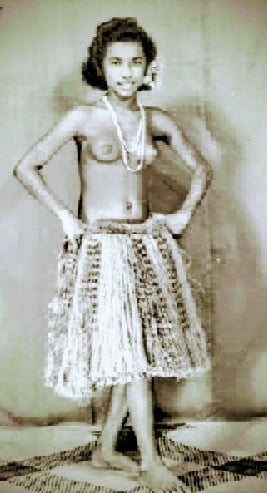
“I was less alone and soft-aired Laloki River is one of my most precious, poetic memories.”
Flynn later observed that, “If you spend more than five years in New Guinea you were done for, you’d never be able to get out, your energy would be gone, and you’d rot there like an aged palm”.
In April 1933, he sold his property and suddenly left the island with some smuggled diamonds and a case of malaria that would plague him for the rest of his life.
During his years in New Guinea, from the age of 18 to 24, Flynn came to maturity and formed his adult personality. New Guinea brought out the worst and the best in him.
He was willing to try anything, but wouldn’t work at anything for very long.
He said, “There is no thrill like making a dishonest buck” and always expected others to support him when he had no money of his own.
He lived by his wits, bluffed his way through crises, and used his fists when he had to.
One of Errol Flynn’s greatest loves was writing. Apart from his autobiography My Wicked, Wicked Ways, he wrote two semi-autobiographical novels Beam Ends and Showdown and in addition wrote articles for the Sydney Bulletin whilst in PNG under the pen-name “Laloki.”
Errol Flynn loved many women, but he is said to have once confided to a close friend that two of his greatest loves were New Guinea, and writing.
— Tim
“ERROL FLYNN EN CARTEGENA”
What would you do if the most popular actor in the world arrives at the door of your house at that time, greets you with your name and asks for permission to enter?
The first thing would be to be amazed and that is what happened to Don Antonio Fuentes, founder of the first record company in Colombia, the one with the yellow seal, the one with the Clock Tower of Cartagena.

Don Toño, as he was familiarly called by his employees and neighbors in La Heroica, was born in Cartagena on May 18, 1907, had toured several countries and even fell in love with the Hawaiian guitar. Upon returning to [Columbia] he set up the Emisora Fuentes and determined to rescue the autochthonous rhythms of the Caribbean. In 1934 he made the first productions of figures such as Guillermo Buitrago, Esther Forero, Los Trovadores de Barú, Lucho Bermúdez, Los Corraleros de Majagual, Pedro Laza, Rodolfo Aicardi, Los Hispanos, Gustavo Quintero and dozens of other groups.
La Heroica, Cartagena:
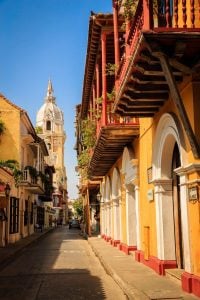
I always asked the artists if they had “some verses” out there and with that, I was able to do a whole song and a success. Sometimes the musicians would tune or give one more note and Don Toño would simply say, “leave that so that’s what you’re going to like”, as indeed it happened.
Thanks to the contacts of Don Toño Fuentes, the recordings were reproduced in countries such as Mexico, Cuba, Argentina, Venezuela and the United States. He had a recognition in many countries and was the great ambassador of Colombian music.
For his part, Errol Leslie Thomson Flynn, known as Errol Flynn, was the most popular actor in the decades of the 30s, 40s and 50s and was born in Hobart, Australia on June 20, 1909. He was nationalized as an American and became a star for his characters of heroes, where he combined great kisses with his adventurous movements.
One of those roles was the first version of Robin Hood, where despite appearing in green tights, a hat with feather and leather gloves, conquered the hearts of thousands of young people who melted to see the way they twisted the lips of the protagonists of the stories.
He is remembered for his roles in films such as “The Light Brigade’s Charge”, “Robin of the Woods”, “The Private Life of Elizabeth and Essex”, “Camino de Santa Fe”, “They Died with Their Boots on”, “The Island of the Corsairs”, “Swords Crossed”, of a roll of more than 50 films.
As a fan of yachting he sailed to Cartagena, according to Don Gabriel Pulido, promoter of Discos Fuentes in Bogotá. When he arrived at the walled city, he did not have a hard time finding the house of Don Toño Fuentes, where he was well received, tasted good rums, ate up the head of a cat, dined on the beaches and danced the best of coastal music.
It was an unforgettable visit [after which] he continued with films, romance, and adventure.
On October 9, 1959 he traveled to Canada in order to sell his yacht and when he was going to ride the plane back he felt bad, a doctor gave him a few days off and on October 15 he died a heart attack. The idol of the cinema left, after scarcely 50 years, [but not until after] enjoying the rum and rumba of Cartagena.
____________
Here’s a Sound on Sound account of Don Tono and Disco Fuentes:

www-soundonsound-com.cdn.ampproject.org…
— Tim